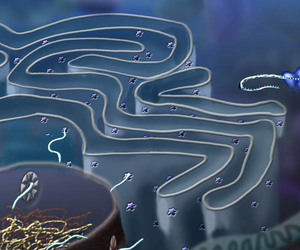Jan. 12, 2007 Research Highlight Biology
STIMulating calcium influx
Researchers demonstrate the critical role of a protein in mobilizing calcium ions
 Figure 1: An artistic representation of endoplasmic reticulum. © Nicolle Rager Fuller, National Science Foundation
Figure 1: An artistic representation of endoplasmic reticulum. © Nicolle Rager Fuller, National Science Foundation
Calcium ions are used by various cell types, including immune cells, bone cells and neurons, to regulate their physiological response. Now, Tomohiro Kurosaki and colleagues from the RIKEN Research Center for Allergy and Immunology, Yokohama, and other academic institutions in Japan, provide new details of how the cell senses low intracellular calcium levels, potentially leading the way to future drug therapies1.
Typically, calcium is sourced from stores in an intracellular compartment known as the endoplasmic reticulum (Fig. 1). When these stores are depleted, the cell must transport more from the extracellular milieu. Important in this process is a protein in the endoplasmic reticulum called STIM1. Upon calcium depletion, STIM1 is transported to the region underneath the plasma membrane, where it communicates with calcium transport channels residing in the plasma membrane, thereby facilitating calcium influx into the cell2.
Kurosaki and colleagues show for the first time that STIM1 normally resides in a special sub-compartment of the endoplasmic reticulum. Also, while confirming earlier studies demonstrating that calcium depletion stimulates STIM1 to translocate to regions near the cell’s surface, the team shows that it is not inserted into the plasma membrane. They suggest that STIM1 must trigger calcium influx indirectly by activating calcium transport channels within the plasma membrane. How this actually occurs will be an important issue for future studies, says Kurosaki.
By removing specific portions of the protein’s structure through genetic engineering, the team further shows that several different regions of STIM1 are required for calcium influx to occur. Interestingly, STIM1 appears to use these regions in different ways to facilitate its movement to the region underneath the plasma membrane. For example, removal of one region blocked the first step in the transport of STIM1, while removal of others either blocked subsequent transport steps or slowed its kinetics. But in all cases, none of the mutated protein made it to the region underneath the plasma membrane in appreciable amounts to properly trigger calcium influx.
Kurosaki points out future studies are needed to “clarify the mechanism of how low intracellular calcium levels stimulate STIM1 to leave the endoplasmic reticulum since the protein’s movement is one of the critical points of its regulation". He also believes that some day drugs that target STIM1 may be therapeutic since many cell types, including immune cells and bone-degrading cells, depend on proper calcium oscillations for their activation and function. However, he notes that since STIM1 is expressed widely, these drugs would have to be well-targeted to avoid unwanted side-effects.
References
- 1. Baba, Y., Hayashi, K., Fujii, Y., Mizushima, A., Watarai, H., Wakamori, M., Numaga, T., Mori, Y., Iino, M., Hikida, M. & Kurosaki, T. Coupling of STIM1 to store-operated Ca2+ entry through its constitutive and inducible movement in the endoplasmic reticulum. Proceedings of the National Academy of Sciences USA 103, 16704–16709 (2006). doi: 10.1073/pnas.0608358103
- 2. Spassova, M.A., Soboloff, J., He, L.P., Xu, W., Dziadek, M.A. & Gill, D.L. STIM1 has a plasma membrane role in the activation of store-operated Ca2+ channels. Proceedings of the National Academy of Sciences USA 103, 4040–4045 (2006). doi: 10.1073/pnas.0510050103
